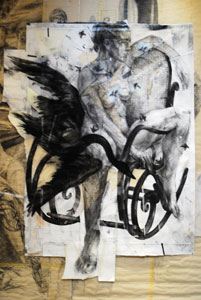The Art of Allusion and Illusion
By Karl F. Volkmar

James Drake: When the Swan is in the Sky, 2009
Shifting gears, in James Drake’s grand baroque theater drawing, Dancing in the Louvre, the elegantly simulated moldings mediate the viewer’s imaginative transgression of the proscenium plane. The gown that overflows into the foreground space, the dynamic diagonal and counterpoint of the dancers’ elegantly dressed forms, and the two point perspective defined by the pedestal at the left and the voyeur couple on the right serves to establish a continuum from the viewer’s real world space through the fore, middle, and implied distance.
Drake’s bold, grisaille trompe I’oeil, created through the agency of virtuoso handling of the charcoal medium, deploys witty allusions to Renaissance and Baroque quadro riportato paintings that will delight the historically conscious. The nuanced range of values, sweeping gestures and movement, and intuitive mastery of the algorithms of perspective and foreshortening produces a dreamlike world in which the relationship between subject and objective dissolves in a delightful mixture of fantasy, illusion, and realism in the tradition of Mantegna, da Cortona and Gaulli, and twentieth century film fantasies featuring Fred Astaire. With the consummate intuitive knowledge of what medium to use to create the most desired effect, Drake’s decision to work with black and white and gray seems to have been the most effective choice.
In Barca de Oro, the mysterious man and boy child playing in the waves exudes a bizarre, even malevolent, character when one notices the deteriorating corpse drifting ashore. Detritus from Gericault’s Raft of la Meduse? Wraithlike figures of scarcely discernable forms float in the air as ambiguously as the daemons in Schoengauer’s late medieval Temptation of Saint Anthony. Such comparisons become even more interesting to cultural historians in that both Schoengauer and Drake created their work on the verge of major shifts in cultural paradigms. The viewer, by virtue of drawing’s heroic scale, is both observer of, and participant in, the illusion.
When the Swan is in the Sky references the mythological story of Leda and the Swan so sensuously represented in the Renaissance. Stylistically, and conceptually, Drake’s drawings embody empathies with multiple sources – elements of Titian combined with the sensibility of Philip Pearlstein, a smidgen of Rauschenberg and the expressive energy of De Kooning. In Fat Boy, the artist’s pastiche and palimpsest of images and media is kinfolk twice or thrice removed of the Starn Twins.
Drake’s drawings appeal to a wide range of potential viewers depending on their education and interests at the moment. Like the Fred Astaire and Ginger Rogers fantasies that fascinate as romantic narrative and have influenced some of the most able artists in twentieth century dance with their consummate and immaculate artistry, artists like Kelly, Nureyev, and Baryshikov, so does one delight in the fantasy and illusion and the multiple art historical allusions. For the intellectual, typically university trained, mind, the plethora of historical references can be as exhilarating as standing on Saint Charles Avenue amid cascades of beads thrown by intoxicated riders on a stalled Krewe of Bacchus Alligator Superfloat. Drake takes full advantage of the postmodern license to meld popular culture, high art and kitsch, and esthetic delight and intellectual satisfaction into one art experience.
